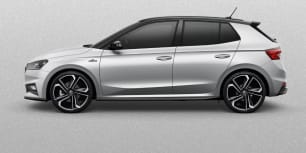The new-gen Fabia shares a vehicle platform with its Volkswagen Polo cousin and has grown in every dimension except height over the previous model.
Up front, you get a great driving position and feel lower to the ground, helping the connection with the road.
There's decent head and shoulder room in the front row, and those sports seats offer significant lateral support, almost hugging your torso. They are comfortable and the cloth trim gets a big tick from me.
The dash design and layout is bordering on busy but all controls are easy to identify. I will never understand why some carmakers insist on using a steering wheel stalk for the cruise control when it is much easier to operate from the steering wheel itself. Make it happen please, Skoda!
The sizeable 9.2-inch multimedia touchscreen uses capacitive touch and is relatively simple to navigate.
The Fabia has two USB-C ports up front and a 12-volt charge point in the central storage bin.
Speaking of, the central compartment is average in size but will fit a phone or two. For the moment, there is no removable front cupholder in the Fabia, but it is offered as an accessory. Skoda Australia said it was due to a mistake in ordering and that it will be fitted as standard in Fabias built from October onwards.
There's extra space next to the wireless charging pad for another device, the glove box is big, and there's ample room for big bottles in the door cavity. The Fabia comes with a number of Skoda touches - hello, umbrella in the door - including a tiny waste bin for the door storage, which I think is a simple but brilliant idea.
In the second row, you'll find lower air vents, a pair of USB-C ports, ISOFIX points on the outboard seats, three tether points and a small storage tray over the transmission tunnel. But you won't be able to fit larger bottles in the doors.
It is tight back there, too, especially behind my 183cm (six foot) driving position. The chunky sports seats seem to eat into rear seat legroom, so it will be interesting to see how much space there is in a lower grade model without those seats.
The Fabia's boot can swallow 380 litres with all seats in place, increasing to 1190L with rear seats lowered.
That is a bit more than the VW Polo (351L) but can't quite match its SUV stablemate, the Skoda Kamiq (400L).
Extra cargo features, standard on the Monte Carlo, include a luggage net system, extra hooks that can be attached to the rear ISOFIX hooks, and a multi-function storage hammock that can be used for delicate items or just extra security in the boot.





































